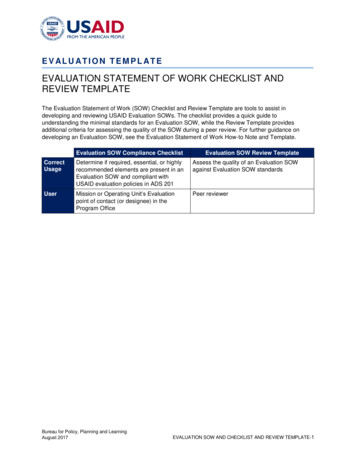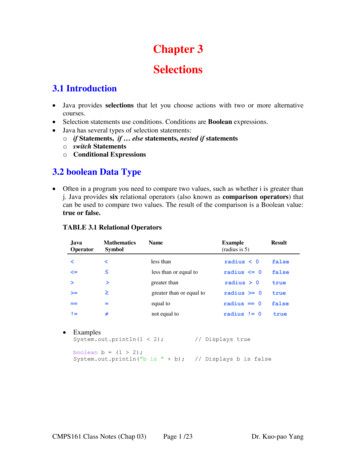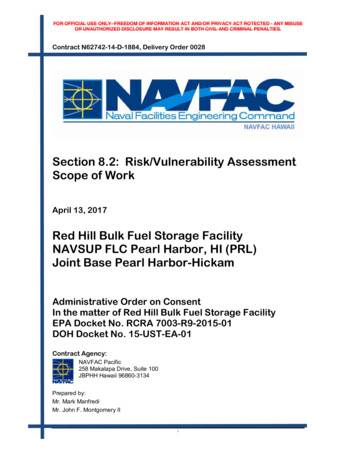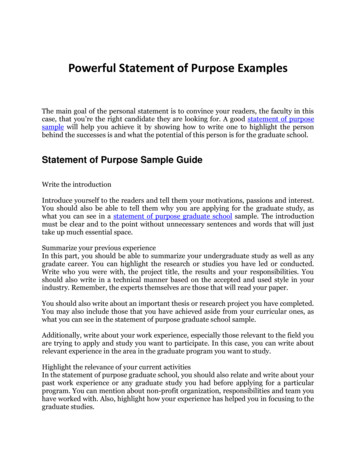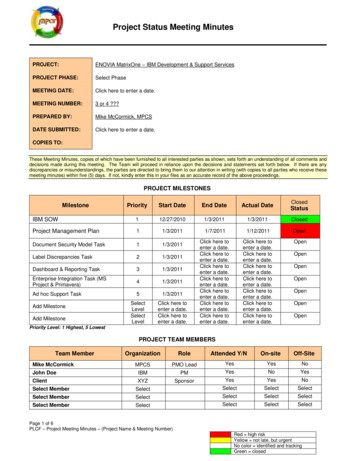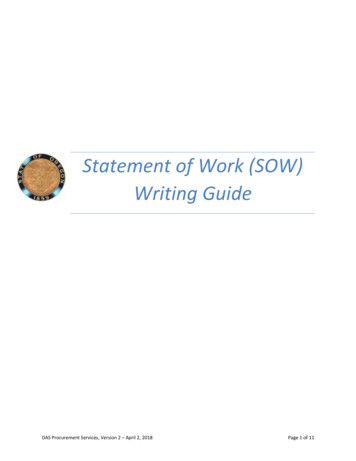
Transcription
Statement of Work (SOW)Writing GuideDAS Procurement Services, Version 2 – April 2, 2018Page 1 of 11
TABLE OF CONTENTSIntroduction . 3Scope of Work vs. Statement of Work . 3Statement of Work Writing Style. 3Defining the Contract Work . 4Statement of Work Types . 5Functional SOW. 5Performance SOW. 5Design SOW . 5Elements of a Statement of Work . 6SOW elements. 6Project Description and Overview of Services . 6Applicable Standards and General Requirements . 7Project Deliverables and Tasks. 7Additional Considerations. 8Acceptance Standards. 8Consistent Task Numbering and Naming . 8Delivery Schedule and Milestones . 8Definitions and Acronyms . 8Style Guide for SOW Language . 9Use Unambiguous Language . 9Proper Use of Acronyms . 9Consistent Terminology . 9Use Active Voice Sentence Structure . 10Assign Responsibility . 10DAS Procurement Services, Version 2 – April 2, 2018Page 2 of 11
IntroductionA statement of work means all provisions of a contract that describe the services or work to beperformed or products to be delivered by a contractor, subcontractor, or agency, as specified in thedocument. A statement of work’s products may include any related technical specifications, deadlines,or deliverables.DAS Procurement Services developed this writing guide as a resource for agencies to organize anddevelop the content that is required in a statement of work. For additional information or assistance indeveloping a statement of work, contact the agency’s Designated Procurement Officer (DPO).Scope of Work vs. Statement of WorkThe statement of work is the primary means through which an agency communicates performanceobligations and duties delivered through a contract. Sometimes a statement of work is confused with ascope of work. These two terms can often share the same SOW acronym, but they have very differentmeanings.The scope of work is a component of a solicitation and describes an agency’s needs and desiredoutcomes for the procurement. The scope of work helps to ensure that the product or service meets thedocumented needs and establishes the parameters of what could be included or amended into theresulting contract. Write the scope of work in a way that a potential respondent can: Understand what services the agency is seekingDecide if it is qualified and capable of performing the services requiredDecide if it wishes to compete for the contractThe statement of work is the core of the contractual relationship with the selected supplier. Thestatement of work describes the roles and responsibilities of all parties to the contract anddemonstrates a commitment on behalf of all parties.The scope of work is a description of what the agency is looking for in a contract and the statement ofwork describes the work to be completed as agreed to by the parties to the contract. All servicesincluded in a statement of work must fall within the scope of work described in the solicitationdocument.For the purpose of this writing guide, the SOW acronym is limited to a statement of work. Refer to theDevelop Specifications webpage in the Oregon Procurement Manual for more information ondeveloping specifications for a solicitation document.Statement of Work Writing StyleThe statement of work is the heart of the contract and is subject to contract law. The SOW describes thedetails of performance and is the gauge against which contractor performance is measured. A goodstatement of work is unambiguous, complete, accurate and logical enough to be understood by aprospective contractor during the solicitation process, all parties to the subsequent contract, and allDAS Procurement Services, Version 2 – April 2, 2018Page 3 of 11
prospective individuals who may read and interpret the SOW, including contractors, their suppliers,project managers, and the contract administrator, among others.Bear in mind when drafting a statement of work that it must clearly communicate an agency’sexpectations from the prospective contractor. A SOW is legally enforceable and must meet a basic“fitness for use” quality standard. Fitness for use means that the procurement team must write thedocument with sufficient detail to obtain products or services that will meet the intended purpose.Use the active voice to eliminate confusion. Structuring a sentence with active voice communicatesauthority and makes it clear to the reader who is to perform the duty. A sentence structure with passivevoice can lead to misunderstandings about who is responsible for the action and can lead to confusionand complications when administering the contract.Defining the Contract WorkDuring the solicitation process, and when engaged in evaluation or negotiation, the team should analyzethe procurement scope of work to determine the specific products or services that will be required inthe contract and the outcomes that must be met. After validating the products or services that will beincluded in the SOW, efforts will focus on outlining the entire process to ensure completeness, internalconsistency and good organization.Throughout this process, evaluate options for performing and delivering the services that include: Whether the agency can complete any or all of the work with internal staff resources.Whether there are any agency, federal, or industry regulations that dictate how services ordeliverables must be completed.Whether the work should be done using a phased development approach.These planning factors can significantly influence how the SOW is structured. The procurement teamshould seek to understand the impact of these considerations early in the planning process andcontinually reassess their significance as the team progresses on its analysis and breakdown of the work.Other factors to address during the planning stage include: What will the work consist of?Who should review and provide input into the SOW?Who is responsible for performing specific tasks?Have any reports, documents, or other elements related to the project already been completedby agency or other contractors?What are the deliverables and when are they due?What quality standards to apply to the deliverables or performance of the work?Who will receive the deliverables?Are the services recurring? If so, what service level will have a real impact on customersatisfaction?What will a successful outcome be?DAS Procurement Services, Version 2 – April 2, 2018Page 4 of 11
What possible problems could arise? What are options for resolving?Are there any special requirements such as travel, mandatory credentials, or minimumexperience levels?Statement of Work TypesThere are three main types of statement of work: Functional SOW.Performance SOW.Design SOW.Consider the characteristics of each SOW type in the planning approach.Functional SOWA functional SOW describes requirements in terms of their end purpose, expected result or finalobjective: Focuses primarily on the “what” aspects of the requirement.May require a particular type of product or approach.Provides a prospective contractor with a specific framework to respond within to satisfy thebuying organization’s needs.Can allow for exception to certain terms and conditions or alternative proposals to provide for abit more flexibility.The functional SOW is the typical form of a statement of work for services and agency management andoversight activities are a component of the SOW.Performance SOWA performance SOW is similar to a functional SOW; however, it defines requirements in terms ofminimum acceptable standard or ranges of acceptable performance and does not prescribe process: Leaves most of the “how to” decisions to the contractor.Strengthens innovation.Enhances competition because the SOW enables a contractor to use its company’s strengthsand creativity to satisfy the requirement.A performance SOW can be complex to create and manage in an environment where extensivespecifications drive the SOW.Design SOWUse the design SOW when the agency requires a specific product or service and is capable of developingan extremely detailed design document: Usually defines all required materials, production processes, and specifications such as size,shape, color, tolerances, etc.Frequently provides requirements for quality, inspection and packaging.DAS Procurement Services, Version 2 – April 2, 2018Page 5 of 11
Managed with care to ensure the extensive specification process does not restrict competitiveprocess.The design SOW is ideal for manufacturing, construction, software integration, and mandatedacquisition projects.Elements of a Statement of WorkThe extent to which a SOW is functional-, performance- or design-based will affect the degree of detailin the SOW elements.A contract for services (functional or performance-based SOW) must define desired outcomes, and asapplicable, identify the work to accomplish in order to satisfy the overall requirement. A prospectivecontractor can have considerable latitude in structuring its approach to the tasks. With this latitudecomes maximum responsibility and accountability for the results of the work.A design-based SOW allows no flexibility for a prospective contractor to propose a solution for therequired need. A contract for product or service design (design SOW) defines both the required resultsand the method of achieving those results. The primary risk in being overly prescriptive in a SOW is thecontractor’s unwillingness to accept responsibility for results because it performed the work in themanner specified in the contract.SOW elements Project description and overview of services.Applicable standards and general requirements.Project deliverables and tasks.Acceptance standards.Consistent task numbering and naming (optional).Delivery schedule and milestones.Definitions and acronyms (if applicable).Project Description and Overview of Services Describe the project purpose and objectives:o What the project will achieve?o What statutory authority exists for the project?o Why the work in the SOW is being pursued?o Who is involved in the project?Provide background information that will aid a contractor in understanding the nature andorigin of the requirements:o How the project came about.o Why the project is needed.o Relationship of the project to other agency goals and major programs.o Other projects related to the work defined in the SOW.Outline the scope of services covered by the SOW.DAS Procurement Services, Version 2 – April 2, 2018Page 6 of 11
Applicable Standards and General RequirementsIdentify applicable standards, regulations, manuals, permits, special certification or licenserequirements, etc., that must be met and are not already incorporated in the SOW from elsewhere inthe contract or master price agreement.Project Deliverables and TasksProject deliverables are the end-products or services that a contractor submits to an agency foracceptance. Deliverables are a critical link to the contract as the acceptance or non-acceptance of eachinforms the actions of a contract administrator.A deliverable must satisfy one or more of the requirements documented in a statement of work. Anexample of a deliverable includes a system, an application, a program or a product. On the other hand,project work products, such as project schedules, plans, and progress reports are used by an agency tomonitor progress toward the completion of an end-product. Project work products are not typicallyincluded in the deliverables.Describe the project deliverables, addressing each of the following deliverable characteristics: Links to one or more project goals and objectives.Gives sufficient detail to make it distinguishable from related deliverables.Describes a standard for performance in a way that enables testing to verify that it meets thestandard.Provides a means to trace its requirements and to monitor and ensure its quality throughout theproject lifecycle.Enables an acceptance process.Ties to a compensation structure that is consistent with the work performed.Describes a contractual remedy, if appropriate.Project tasks are the activities that must be performed to produce the project deliverables andoutcomes.Describe the project tasks, addressing each of the following task characteristics: Assigns a specific period, with start and finish dates.Reflects an estimate of hours to complete.Assigns responsibility.Identifies resource requirements.Identifies any key internal and external project dependencies.Appears in logical sequential order based on when it must be undertaken.Relates to another task, a project milestone or a deliverable, as applicable.Includes tasks that do not result in specific deliverables (e.g., project management tasks).Includes tasks performed by the agency.Best Practice: Begin the process of identifying and defining deliverables by describing the project’smajor work streams and defining the tasks under each work stream. This activity creates a workDAS Procurement Services, Version 2 – April 2, 2018Page 7 of 11
breakdown structure (WBS). The WBS is a hierarchical-tree diagram that organizes and defines thescope of the project. Refer to Tips for Drafting SOW Tasks for information on creating a WBS.For a performance-based SOW, this section should describe the deliverables and service requirements interms of results needed rather than detailing the tasks or methods for completing the work. Thislatitude will permit the contractor to develop new and innovative ways to complete those tasks. In thistype of SOW, focus on establishing relevant and well-defined baselines for contractor performancemeasurement.For a design-based SOW, this section should provide a sufficient level of detail to enable the prospectivecontractor to plan personnel utilization and other requirements with maximum efficiency.Additional Considerations State, when applicable, the place or places where the work is to be performed and the regionswithin which travel may be necessary.If the contractor is to use any furnished data, property, or facilities in performing specific tasks,state what will be furnished and at what stage.Define a division of responsibilities between the agency and the contractor.If a decision can’t be made immediately regarding task frequency, product quantity or otherSOW requirement, include a procedure by which the decision will be made.Acceptance StandardsThis section of the SOW describes the deliverable review and acceptance process and delineates thereview criteria. The SOW should establish management control points as milestones in the sequence oftasks where the agency takes actions for review, approval, acceptance or rejection. Refer to the DeliverySchedule and Milestones paragraph below for more information.Acceptance standards are the objective criteria an agency will use to determine if the product or servicemeets requirements.Consistent Task Numbering and NamingThough not required, the best practice for a services statement of work is to use standard tasknumbering. The WBS provides one framework for organizing and numbering tasks. Refer to Tips forDrafting SOW Tasks for information on creating a WBS. Alternatively, DAS Procurement Services willcreate a numbering convention for the tasks submitted with the request.Delivery Schedule and MilestonesIdentify due dates for deliverables or completion of tasks. Also include milestone dates for any criticalpath items that could jeopardize the overall project schedule (e.g., cutoff dates for obtaining permits tomaintain bid let schedule).Definitions and AcronymsInclude in this section definitions of terms not generally understood and acronyms that are usedspecifically in the SOW and no other sections of the contract. Use defined terms and acronymsconsistently throughout the SOW.DAS Procurement Services, Version 2 – April 2, 2018Page 8 of 11
Style Guide for SOW LanguageUse Unambiguous LanguageAmbiguous language means words that have more than one interpretation – uncertain or indefinite.Avoid words or phrases such as "assist", "work with", "help", "best efforts", "reasonable", "acceptable","necessary", "good", "they", and "we". Instead, choose words and phrases that clearly defineresponsibilities, intentions and expectations.The interpretation each party (agency and contractor) has about SOW language may not match or maychange over time. New people assigned to the contract may bring different interpretations. CreatingSOW language that is clear and concise reduces confusion.Proper Use of AcronymsSOW writing is technical writing and oftentimes requires using uncommon names or expressions. Whenusing acronyms assume the reading audience is not a subject matter expert. For all acronyms, spell outthe name or expression when using for the first time in the SOW and then identify the acronym inparentheses. Once defined, use the acronym throughout the rest of the SOW.Example: This Work Order Contract (WOC) is for Preliminary Engineering (PE) services necessaryto develop the Design Acceptance Package (DAP) for the project. The PE work to develop theDAP is a new phase of the project, distinct from and in addition to the previous phase(s)completed in WOC 1.If there are several different acronyms used throughout the SOW, consider including a table ofacronyms and definitions at the beginning or end of the SOW.Consistent TerminologyIt is important to use consistent terminology throughout the SOW. When referring to a party of thecontract in the SOW, use the term defined in the contract for that party. When referring to a specifictask or deliverable in the SOW, use the same term or phrase used to define the task or deliverable. Forinstance, refer to a deliverable titled "Technical Memorandum #1" by that title consistently throughoutthe SOW. QuantitiesWhen identifying a quantity, use the numerical digit in lieu of spelling out the numeral followedby the digit in parenthesis. For example, "Contractor shall prepare alternatives analysis for 3alternatives" is preferred to "Contractor shall prepare alternatives analysis for three (3)alternatives."When quantities are changed, errors are more likely to occur when using the latter method. Forexample, "Contractor shall prepare alternatives analysis for three (4) alternatives." Thisinconsistency results in a direct conflict in the executed contract regarding the number ofalternatives contractor is required to prepare. “Agency”, “Contractor", “Consultant”, “Provider”DAS Procurement Services, Version 2 – April 2, 2018Page 9 of 11
When referring to the parties of the SOW, the rule of thumb is to use the same capitalizedwords used to refer to the parties in the contract’s terms and conditions. Consistency of usethroughout the contract is the objective.Generally, for Personal Services contracts, “Agency” means the procuring agency, but can meanthe Department of Administrative Services (DAS) if the contract is subject to DAS procurementauthority. “Contractor” means the legal or commercial entity with whom DAS or an agencyenters a contract. “Contractor” has the same meaning as “Consultant” or “Provider.”When in doubt about which word to use to refer to a party in the SOW, please contact DAS ProcurementServices.Use Active Voice Sentence StructureBoth active voice and passive voice convey action in different ways based on their grammaticalstructure. Always use active voice when drafting a SOW. Passive-voice sentences create ambiguity thatmay be interpreted as indecisive or evasive. Active-voice sentences usually have three basiccomponents: The actor – the person or thing performing the action.The action – the verb.The receiver – the person or thing receiving the action.A sentence is in the active voice when its structure places the actor in front of the action.Example:Contractoractor (subject)shall prepareaction (verb)an environmental report.receiver (noun)When the structure of the sentence has the receiver in front of the action, the sentence is in passivevoice. If a sentence includes the phrase “will be” or “shall be” it is very likely passive voice.Example:An environmental reportreceiver (noun)will be completed.action (verb)Assign ResponsibilityAlways assign responsibility and requirements for a task in a clear and direct manner using active voicesentence structure and appropriate terms of obligation: Contractor shall.Always use “shall” when the contractor is expected to perform a certain task. The term “shall” isthe customary contract language, which clearly means the contractor must perform theobligations during the term of the contract. For example, “Contractor shall ensure that allemployees are able to respond to any inquiry within x minutes.” Contractor may.Use “may” or “should” only when the contractor is not expected to perform a certain task.“May” is only used for informational purposes in a SOW. It lacks any legal substance forDAS Procurement Services, Version 2 – April 2, 2018Page 10 of 11
enforcement of an obligation in the contract. An example would be “Contractor may include achemical breakdown of soil samples in the report.” Agency will.“Will” usually signifies an action at some undefined point in the future, in the contract, orperhaps in another contract. For instance, “Agency will coordinate the lab tests.” This sentencedoes not clearly define when the action needs to happen. The report must.“Must” is to address requirements for inanimate objects or processes. For instance, “The Reportshall include a table of contents,” is structured so that the report is the actor in the sentence. Inthis case, the sentence should read: “The Report must include a table of contents.”Similarly, “The facilitated meeting shall strive to develop consensus,” should be revised to read:"Contractor shall facilitate the meeting with the objective of developing consensus among theparticipants.” For inanimate subjects, use “must” or re-write the sentence to show who theactor is. Contractor must.Use “Contractor must” when something needs to happen before another action can happen.This indicates that the action is required to bring about a consequence. When determining whento use the word “must,” contemplate if the party “has to do X before Y will happen.” Forexample, “Before proceeding with completion of final report, Contractor must obtain agencyapproval of draft report.DAS Procurement Services, Version 2 – April 2, 2018Page 11 of 11
required need. A contract for product or service design (design SOW) defines both the required results and the method of achieving those results. The primary risk in being overly prescriptive in a SOW is the contractor's unwillingness to accept responsibility for results because it performed the work in the manner specified in the contract.
